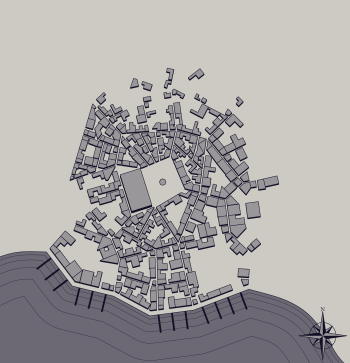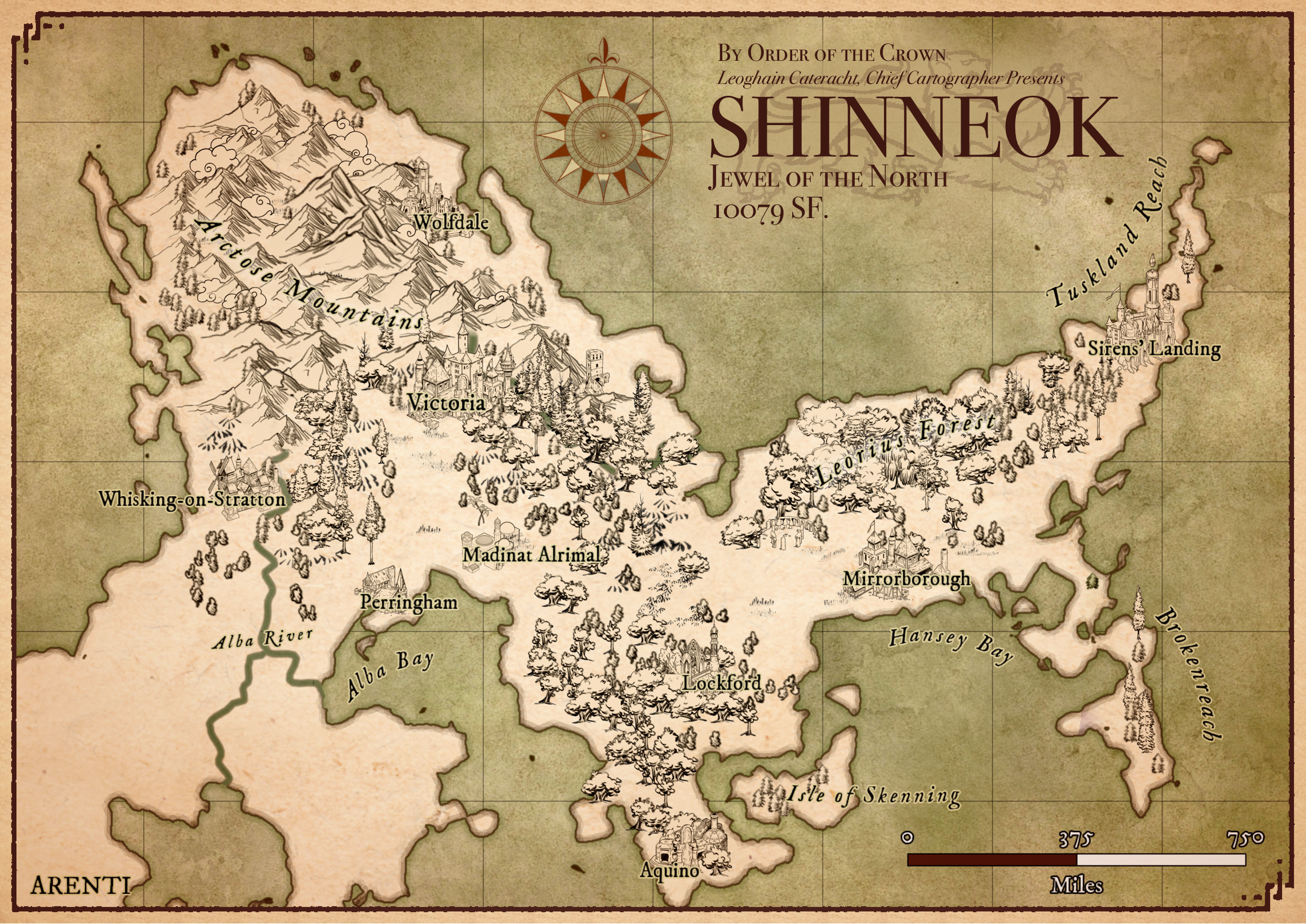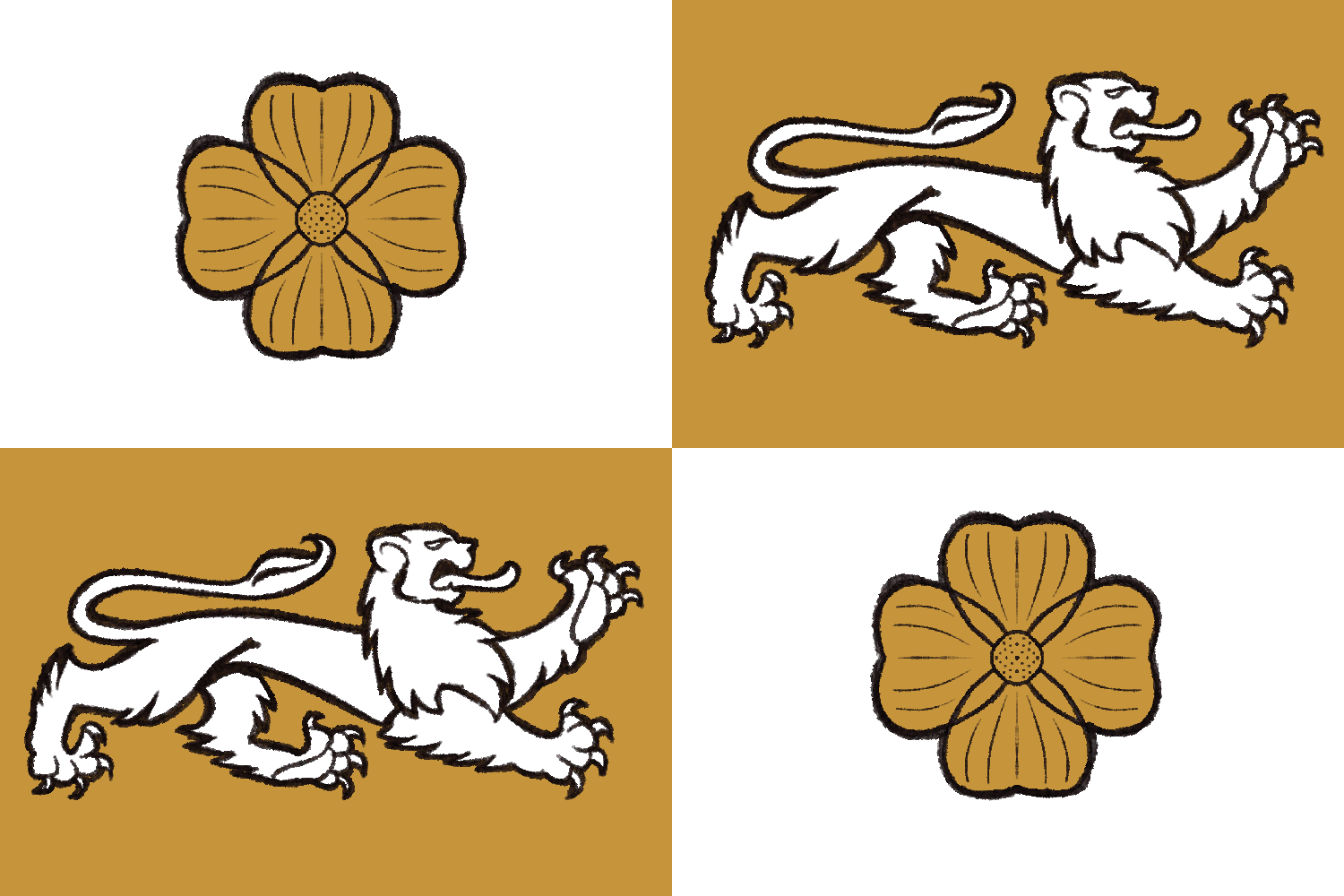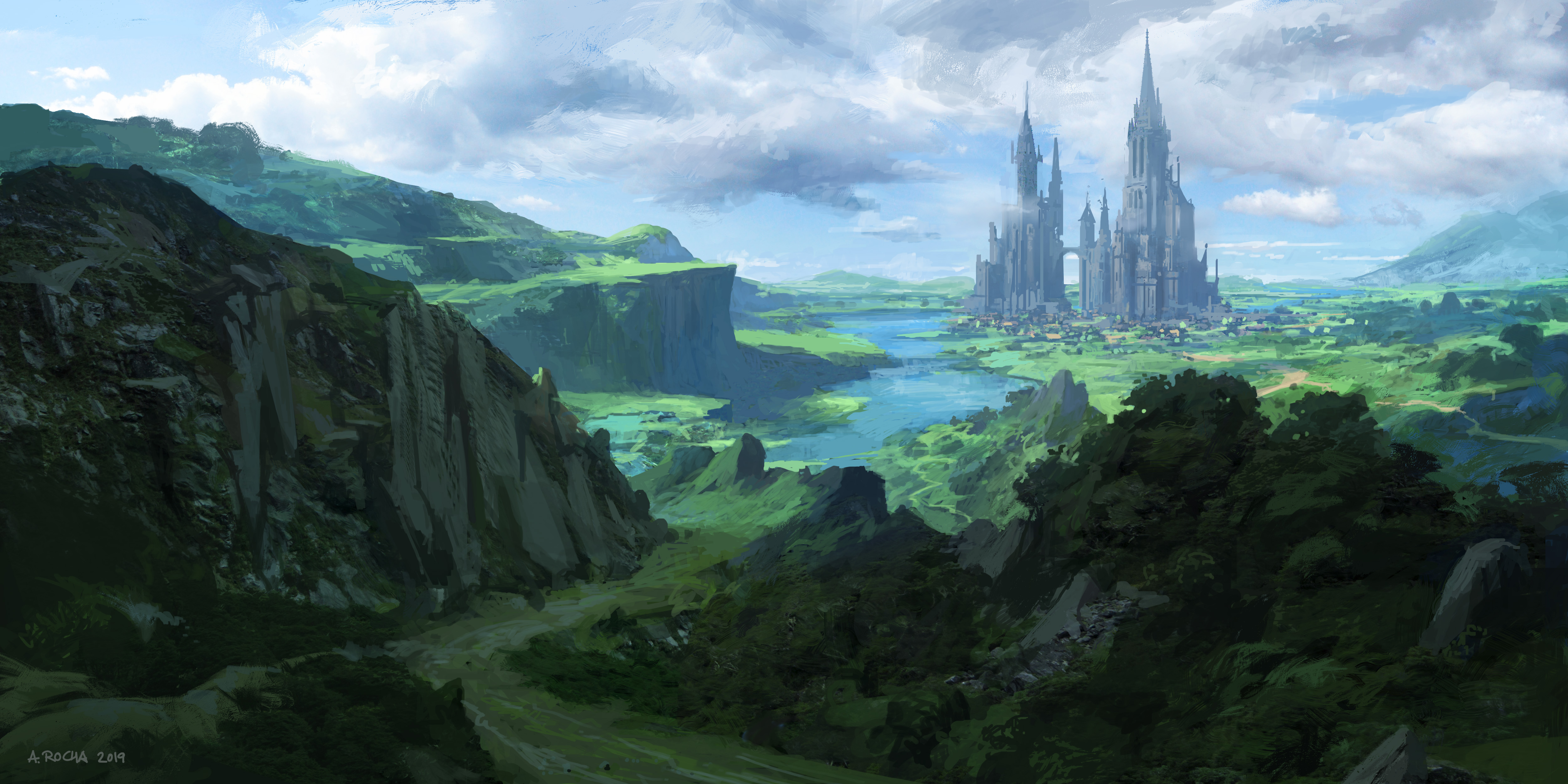Table of Contents
Shinneok
- Government Type: Monarchy
- Symbol: Lion
- Major Races: Humans, Dwarves
- Capital: Victoria
- Demonym: Shinnean
Easternmost and northernmost of the Oxis Alliance, Shinneok stands firm, a bastion against Pthora’s advances and an advocate of antiquity. Its history stems back thousands of years, and to this day remnants of ancient lands are still being unearthed beneath its rolling hills and birch forests. In the summer, this nation can be warm and balmy - though never too hot - and in the winter, temperatures plummet and snow blankets the land. Shinneok is based on the real-world nations of Western Europe.
The Ninite Church of Shinneok and its unique religious tenets have created a lasting mark on Oxis and its surrounding areas. Although traditional Cahyalic faith still remains prominent across the world, enclaves of Ninite worship have become prevalent. Though some claim it to be heresy, direct inquiry to the gods has given no insight to the matter.
Regions
Shinneok has three broad regions recognized as provinces by the Royal Family.
Lakeshire
Bordering Arenti, this province is the smallest in landmass of all Shinneok’s regions. It is pleasant, having many large and small lakes within its borders, hence the name. Lakeshire is mostly concerned with naval transportation, and has many port towns facilitating overseas trade as well as dispatches of naval forces.
Bloomingshire
In the heart of Shinneok is this region, one of the more urbanized and industrialized regions of the country. Most of the population of Shinneok lives in Bloomingshire. Its exports are mostly artisan works and industrial products, which has brought this region incredible prosperity.
Knotthamshire
This province is the easternmost of Shinneok’s areas, and is made up of a pair of peninsulas connecting where it borders on Bloomingshire. Knotthamshire is mainly agricultural, subsisting off farming and fishing. It is a popular tourist destination for the rich from Bloomingshire, and has quite a few sanatoriums.
Governance & Laws
Shinneok is a monarchy, and has been so for centuries - though when a suitable ruler is absent, the order of the Lancer Knights, also known as the Holy Paladins, takes over the country in stead. Other than the crown, two other major governmental institutions exist. The National Parliament is a legislative organization which also operates the courts in its jurisdiction, while the Knights lead Shinneok’s military. In the modern day, all three parts of the government are considered roughly equal in power.
Police presence is commonplace in larger Shinnean settlements, and has more or less faded into the background as a simple and inoffensive fact of life. Most police forces are trained and hired as part of a town’s guards, or are part of the Shinnean military led by the Lancer Knights. A non-exhaustive list of some crimes and punishments follow:
- Theft: 5-10 days incarceration and/or a fine equal to the worth of the stolen goods.
- Open worship of demons, eldritch beings, or fey entities: 1-2 years incarceration and a fine of 800 gc.
- Damage to property, private or governmental: 3 months incarceration and a fine equal to twice the worth of the property destroyed.
- Ownership of another intelligent humanoid creature: Execution or exile from Shinneok for life.
- Assault: 10-15 years incarceration.
- Assault on a public official: 15+ years incarceration.
- Conspiracy against Shinnean royalty: 30-50 years incarceration.
- Murder and rape: Incarceration for life, or execution (depending on degree).
- Treason: execution.
For more information on the history and culture of Shinneok, follow this link: Shinneok History & Overview
Cities of Shinneok
Many settlements exist in the forests and hills of Shinneok, but only the most major towns and cities are listed here.
Victoria, Throne of the Lions: The capital of Shinneok, nestled in the foothills of the mountains to look out across the land. By far the most populated city in the nation, and a center of industrial advancement as it ships in and studies technologies from Ley'Ork and Jaern. Electric lamps light the streets, and one may see an airship humming about the sky on occasion.
Lockford: The arcane center of Shinneok, where a multitude of mages' guilds gather, live, and study. This city is the origin point of many of Shinneok's greatest accomplishments in the field of enchanting, and quite a few Lockfordian guilds have trade agreements with Ulos to procure magical items and scrolls for study.
 Aquino: This town is built half on land and half over water, nearly always filled with a wide assortment of various trading and merchant vessels. It is famous for its striking black sand lime brick buildings adorned with vivid splashes of colored flags and signs, using imported dyes from Arenti, as well as its annual weeklong midsummer festival. There is a tavern named “The Opal Quay” near the docks, owned and operated by a lizard named Hestur.
Aquino: This town is built half on land and half over water, nearly always filled with a wide assortment of various trading and merchant vessels. It is famous for its striking black sand lime brick buildings adorned with vivid splashes of colored flags and signs, using imported dyes from Arenti, as well as its annual weeklong midsummer festival. There is a tavern named “The Opal Quay” near the docks, owned and operated by a lizard named Hestur.
Wolfdale: A city in the far reaches of the Arctose Mountains, involving itself in matters of manufacturing, mining, and metalworking. This city is mainly populated by dwarves, many of whom are refugees from Pthora seeking escape from the fascist dominion. The Shinnean military has a strong presence in Wolfdale, and watches over many of their industrial happenings with a careful eye.
Whisking-on-Stratton: Near the Arentian border, this town of medium size may seem uninteresting - except for the fact that it is a major cultural landmark of Shinneok. The famous playwright Henry Avon was born here and built a playhouse here - the most illustrious in the land. Thespians of the Alliance see Whisking-on-Stratton as the beating heart and soul of all things theater and film.
Perringham: This port city is nestled in a bay near the Arentian border, and engages in not only trade with the rest of the Alliance, but acts as a port to the world as well. Many merchants pass through Perringham at one point or another, and the city itself is practically run by them.
Madinat Alrimal: In the deserts of Dahabu, people hope and pray for oases of lush land in the desert, but this city is the opposite: an arid, hot city smack-dab in the middle of temperate, rolling plains. A holdover from the Dahabi Empire, this city is one of the last bastions of Dahabi culture in the Oxis Alliance, and functions - nominally - as a Dahabu embassy, though the embassy building has been empty for quite a while.
Mirrorborough: This city is famous for its glassblowing and jewelry-making, and attracts tourists from all over the world. It maintains a historic district resembling exactly how Shinneok looked during the Lily Wars, and reenactments are popular.
Sirens' Landing: Easternmost of all Oxian cities, this place is a military garrison located in the Tuskland Reach. Cold year-round and made of austere stone, no one but active-duty soldiers lives here. Life in Sirens' Landing is rough, with soldiers having to keep a constant eye out for Pthoran attacks.
A faraway view of Lockford. By Andreas Rocha; used with permission.
Culture
Legends, Kings, and Wizards
For much of Shinneok’s history, the literacy rate among the common people was low; it has only begun to rise recently during the late reign of the Holy Paladins and extending into King’s Uther’s reign. As such, much of Shinneok’s history was passed down through oral traditions and legends. Even though education has gained more of a focus recently, many stories are still told through the spoken word or via theater.
The legends of Shinneok concern themselves with its royalty, magic, and supernatural beings. Despite all of these things being very real in Cahyali, the majority of Shinneans live simple peasant lives, with many living and dying without even witnessing a single act of magic - not because it is banned or looked down upon in the country, but simply because there are few mages, and the most a small village may have is a single priest. Traveling wizards, therefore, often manage to draw huge crowds - whether they are adventurers come to take care of a threat or simple entertainers there to do parlor tricks.
The rulers of Shinneok are viewed as divine intermediaries by the people, and command the utmost respect. While some kings or lords may be unpopular, worries are often assuaged by the insistence that the gods chose them for a reason. Artifacts such as the Lyndal Crown and Caledbreach are taken as signs of this divine power.
Religion: Ninism
The religion of Shinneok is markedly different than standard Cahyalic religion - though it still falls under the umbrella of Cahyalism, many Shinneans (and surrounding areas, such as Arenti and Nahrul) believe in the teachings of Ninos. These teachings involve the existence of a single grand deity above the others, which Ninites often simply refer to as “God”. The Cahyalic deities, on the other hand, are seen as saints with their requisite domains and referred to as such, although details of worship often remain similar.
Shinnean Ninite churches are grand in their construction, with massive stained glass windows and high, ornate ceilings. It is believed that the more gilded and beautiful the place of worship, the closer it is to the divine. Walking into a Shinnean town, one can spot the spires of the cathedral from anywhere. A specific priesthood usually manages one cathedral, and the services performed there match this priesthood - for example, a convent of Saint Seherine may do readings and divinings from their cathedral, while a monastery devoted to Saint Thoth or Vormaxia may be a massive library or operate a school.
Ninism does not proselytize much, as many followers are aware that mainstream Cahyalic faith may see their beliefs as heretical. In addition, many Ninites view mainstream belief as mostly true, just a little misguided, and elect not to fight that particular battle too hard.
The Jacks
Descended from the chaos of the Lily Wars, a mysterious organization known as the Jacks has been operating in the shadows for centuries. Originally a band of rogues and mercenaries, the Jacks have since evolved to become a freelance “intelligence” organization who can and will do any job… for the right price. Many people refer to them as ‘money-hounds’, people who will do anything at the beck and call of precious, precious gold. Quite a few Shinnean adventurers have their roots with the Jacks.


